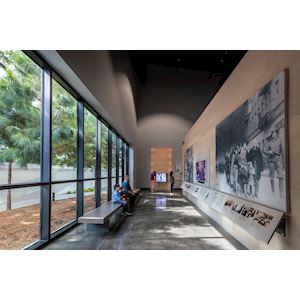
119 - Bearing Witness - Death Marches
NARRATOR As the Allied Forces closed in during the summer of 1944, the Nazis began to march the prisoners toward the interior of their territories. According to historians, the Nazis had several motivations for evacuating their prisoners, including hiding the magnitude of atrocity, keeping prisoners from telling their stories, using prisoners as slave labor to produce last-ditch armaments, and even preserving some prisoners as hostages for future bargaining. Prisoners—already suffering from starvation and disease in the camps—were far too weak to evacuate effectively. Many who were unable to march out were shot on the spot. If they slowed the progress of the march, they were shot and left on the road. Their captors were desperate to evade the Allies and would use locals to help carry out the killing. Siegi Izakson: "For seven days and six nights we marched. We slept outside. It was cold, it is cold in March in Europe, having only blankets…a number of people escaping, some being caught, shot, no hangings, shooting now…" NARRATOR Maria Seidenberger secretly captured an image of prisoners marching to Dachau—photographed from a second-story window as her mother stood outside and gave potatoes to the prisoners. The camp evacuations killed countless prisoners who had—against all odds—survived the camps. No one knows how many died in these marches. Of the dozens of death marches, a few stand out: Three thousand prisoners were marched out of Stutthof camp. Most of them female prisoners. As the Soviet Army neared, the prisoners were lined up on a cliff and machine-gunned. They fell into the freezing water below. The ones who survived were killed by local civilians. After 1500 prisoners too weak to march were killed at Ohrdruf, the remaining 12,000 were marched 31 miles to Buchenwald. More than 3,000 were killed along the way. From Neuengamme, ten thousand prisoners were marched onto ships that were later mistaken by the Allies’ bombers as German troop transports. The Allied attack resulted in more than 7,000 prisoner deaths. As the US army advanced on the town of Gardelegen, German SS guards locked at least a thousand evacuated prisoners of war in a large barn, soaked it with gasoline, and set it on fire. Prisoners who tried to dig out were shot. Even with victory no longer a possibility, German leaders continued to pursue their agenda of death.


Holocaust Museum Houston
Holocaust Museum Houston is dedicated to educating people about the Holocaust, remembering the 6 million Jews and other innocent victims and honoring the survivors’ legacy. Using the lessons of the Holocaust and other genocides, we teach the dangers of hatred, prejudice, and apathy.
- 5401 Caroline
- Houston United States
- 713-942-8000
- www.hmh.org
